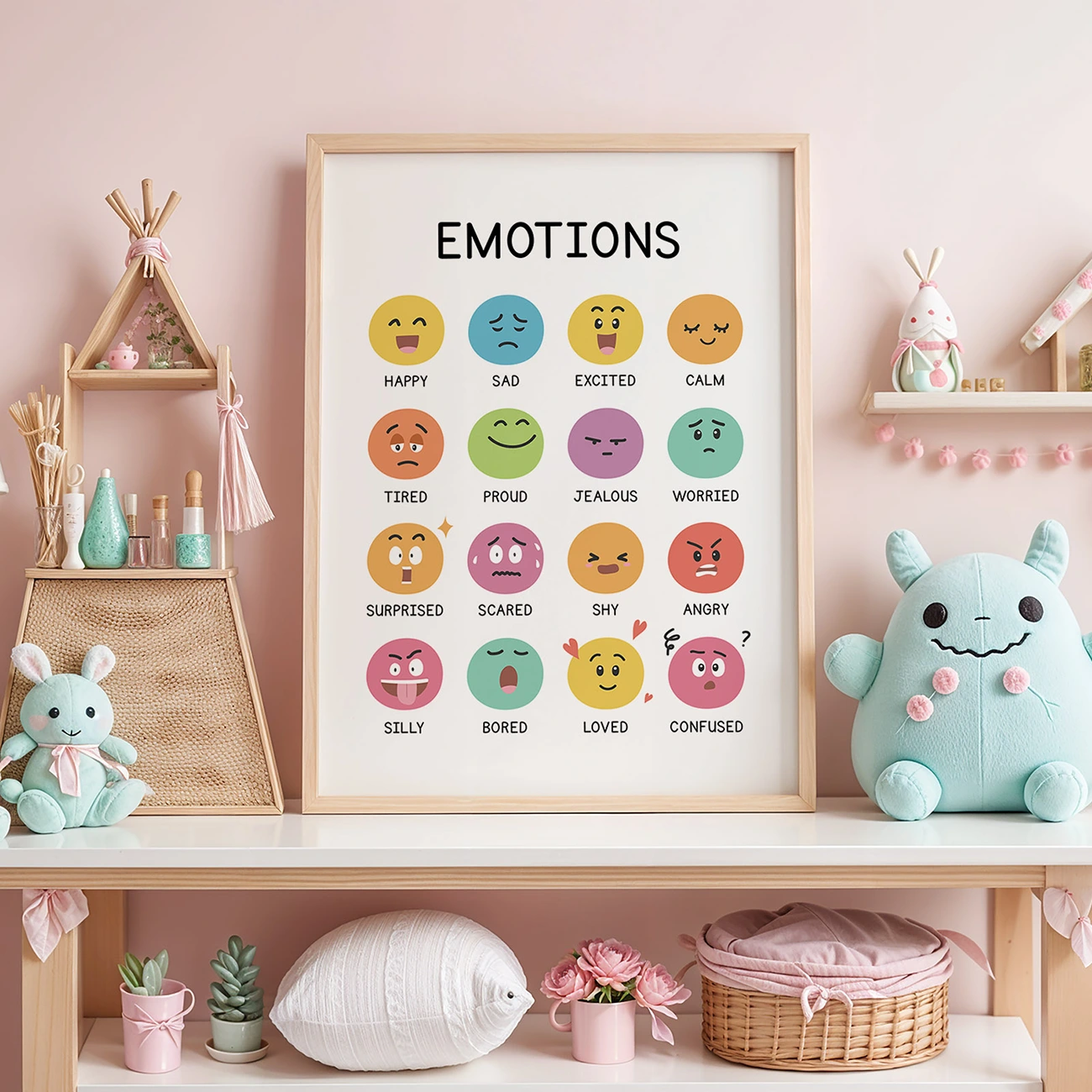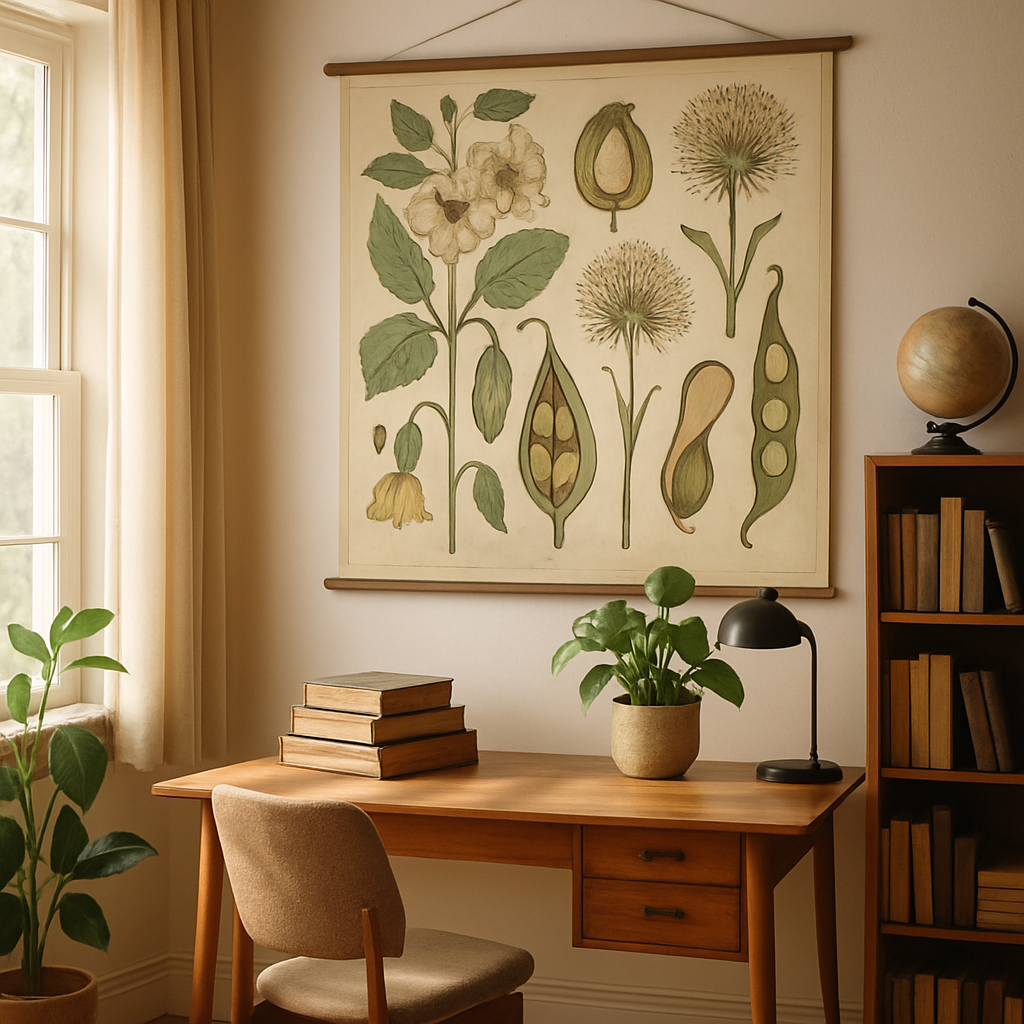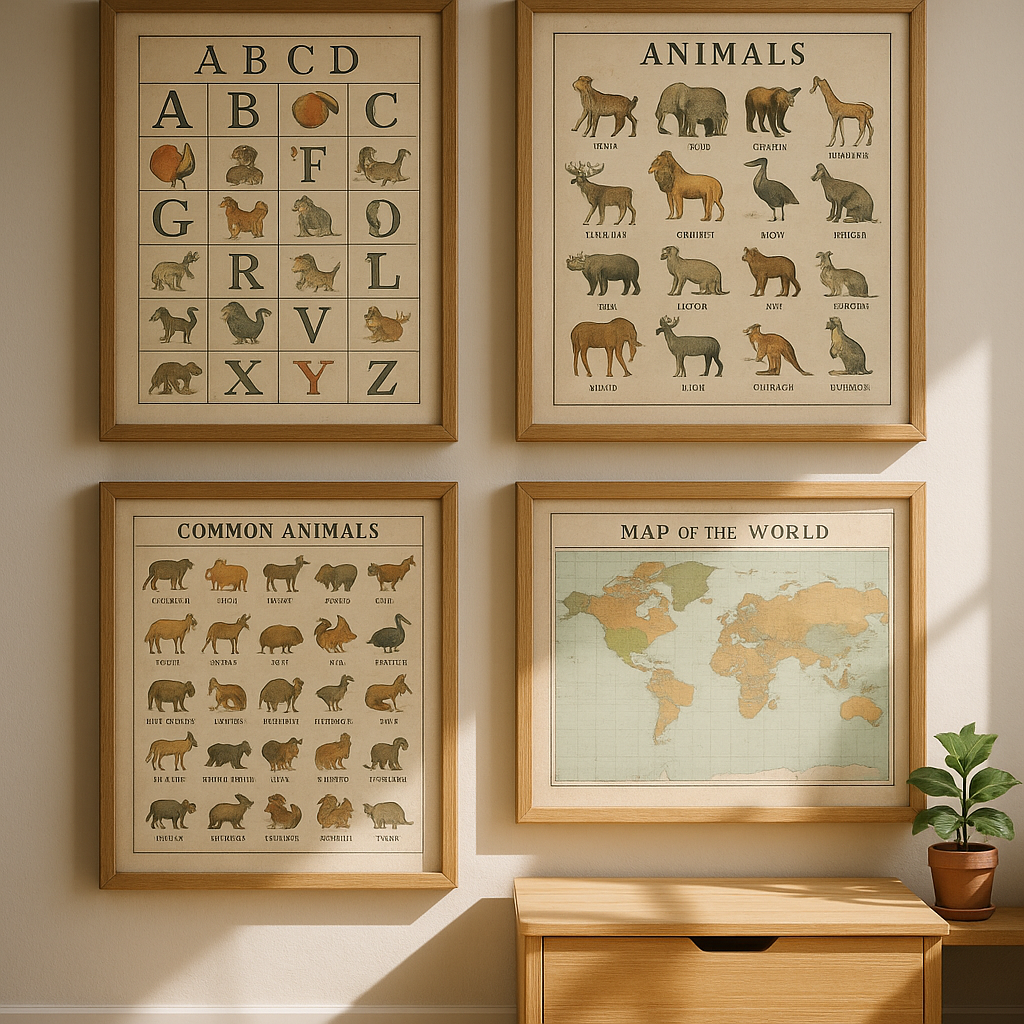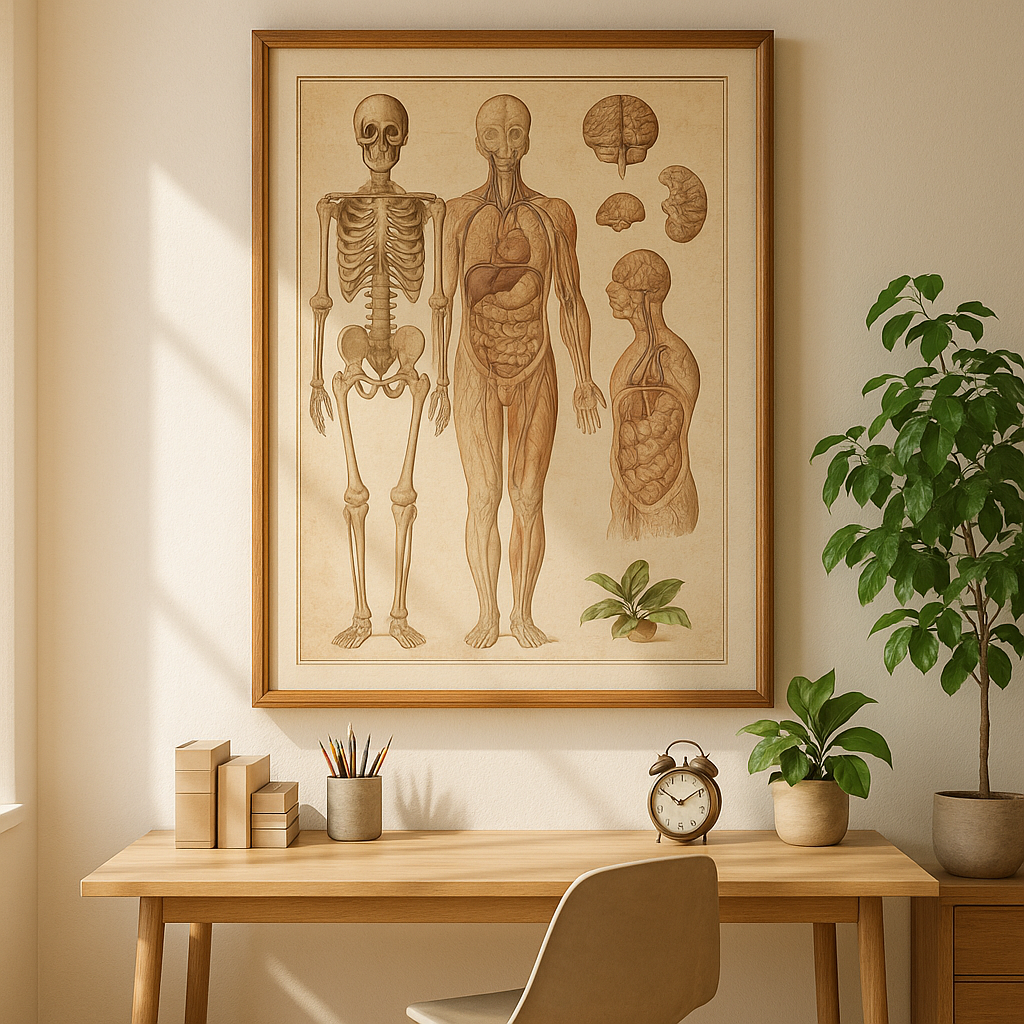Educational Vintage Posters: A Nostalgic Way to Learn & Decorate

Educational Vintage Posters: A Nostalgic Way to Learn & Decorate
Educational vintage posters occupy a special place in our visual culture, bridging the gap between practical teaching tools and captivating artwork. These distinctive pieces—typically produced between the 1920s and 1980s—feature scientific illustrations, historical timelines, geographical maps, and botanical studies that were once classroom staples. Today, they’ve found new life as both learning resources and statement decor pieces.

Vintage is having a major moment. From fashion runways to interior design magazines, the influence of the past is everywhere, and these educational wall charts are riding this wave of nostalgia.
In this article, you’ll discover the enduring charm of these historical teaching aids, learn how to incorporate them into modern spaces, understand their continued educational value, and get tips for building your own collection of these nostalgic treasures.
The timeless appeal of educational vintage posters
The allure of vintage educational posters extends far beyond simple nostalgia—though that certainly plays a part. These artifacts connect us to shared classroom experiences while offering aesthetic qualities that complement today’s interior design trends.
Educational posters from bygone eras possess a unique artistic quality often missing in modern educational materials. Botanical illustrations rendered with meticulous detail, astronomical charts with rich colors, and anatomical diagrams drawn with scientific precision showcase both artistic talent and educational purpose. The combination of hand-lettering, careful illustrations, and natural aging creates visual interest that mass-produced contemporary prints rarely achieve.
For many, these wall charts trigger powerful memories of school days—the smell of chalk dust, the sound of wooden desks, and those moments when a teacher would pull down a colorful chart to introduce a new concept. This emotional connection explains why retro educational prints resonate so deeply with people furnishing their adult spaces.
Beyond personal nostalgia, vintage classroom posters represent a tangible link to educational history. They reflect how knowledge was transmitted before digital screens became ubiquitous. Their simplified visual language was designed to communicate complex ideas clearly—a design principle that remains valuable today.
How educational posters reflect changing teaching styles
Educational posters have evolved dramatically across decades, mirroring shifts in pedagogy and cultural priorities. Early 20th-century classroom charts often featured formal, detailed botanical and zoological illustrations influenced by scientific documentation traditions. These gave way to more colorful, simplified designs during the mid-century period as educational psychology embraced visual learning.
The Space Race era brought a surge of astronomy and physics posters with futuristic aesthetics, while the 1970s introduced environmental themes and more inclusive historical perspectives. Each generation of educational posters provides a fascinating window into what society deemed important for young minds to learn.
Today, these vintage teaching aids serve as both historical artifacts and inspiring decor pieces. Whether you’re seeking to create a thought-provoking workspace or add character to a living area, retro and vintage posters offer both intellectual stimulation and design appeal that few other decorative elements can match.
Educational vintage posters in modern decor
The versatility of retro educational charts makes them suitable for virtually any room in contemporary homes and workspaces. Their artistic quality and educational content create instant focal points while adding layers of interest to otherwise simple spaces.
In living rooms, a large vintage astronomical chart or world map creates an impressive centerpiece that sparks conversation. For dining areas, botanical or food-related educational illustrations add thematic relevance while enhancing the atmosphere. Home offices and studies naturally benefit from knowledge-oriented wall art that stimulates thinking—whether anatomical diagrams, historical timelines, or language charts.
Children’s spaces present particularly exciting opportunities for nostalgic classroom posters.

Vintage alphabet charts, animal identification posters, or historical illustrations create stimulating environments that encourage curiosity without the overstimulation of cartoon characters or electronic screens. These timeless pieces grow with children, maintaining relevance from toddlerhood through teenage years.
Professional environments also benefit from thoughtfully selected educational wall art. Law offices might feature vintage constitutional diagrams, while medical practices could showcase anatomical charts. Cafés and restaurants increasingly incorporate botanical illustrations or food science posters that complement their culinary focus.
When integrating these pieces into modern interiors, consider these design approaches:
- create a gallery wall mixing different educational themes for an eclectic library feel
- use a single large-scale poster as a statement piece against a minimal background
- match frame finishes to existing room hardware for cohesion
- group thematically related posters (all botanical, all astronomical) for visual impact
- consider color coordination—many vintage posters feature muted tones that complement contemporary neutral palettes
When selecting wall art for your space, understanding terminology matters. Retro and vintage aren’t the same! Learn the key differences… between genuinely vintage (original items from past eras) and retro-inspired (new items with design elements that reference the past). Both have their place, depending on your budget, preservation concerns, and aesthetic goals.
Learning with vintage: educational impact & best types
The educational value of vintage wall charts extends well beyond their decorative appeal. These visual teaching aids engage learners through multiple sensory channels, making information more memorable and accessible than text alone.
Visual learning through antique educational charts capitalizes on our brain’s remarkable ability to process and retain images. When information is presented through carefully designed diagrams, maps, and illustrations, it creates stronger memory pathways than text-based learning. The artistic quality of vintage educational materials—with their careful hand-rendering and thoughtful layouts—engages viewers more deeply than many contemporary alternatives.
For children still developing reading skills, these visual references provide accessible entry points to complex subjects. Anatomical charts introduce body systems without requiring advanced vocabulary. Historical timelines visualize the relationship between events that might be difficult to conceptualize from written descriptions alone.
Adults benefit equally from these visual teaching aids.

Those learning new skills or languages often find vintage instructional posters helpful for reinforcement and reference. The simplified presentation of complex information serves as an effective memory aid for learners of all ages.
Certain categories of educational wall art prove particularly valuable in home learning environments:
- anatomical charts that make body systems understandable through clear visual representation
- botanical illustrations that teach plant identification and classification
- geographical maps that provide spatial context for history and current events
- language charts featuring grammatical rules or vocabulary with visual associations
- periodic tables and chemistry diagrams that simplify complex scientific concepts
- astronomical charts that introduce celestial bodies and spark interest in space
For families with young children, kids room posters with educational themes create environments that nurture curiosity and learning through everyday exposure. Unlike electronic learning tools, these wall-mounted resources remain visible throughout the day, allowing for spontaneous moments of discovery and discussion.
Finding & collecting educational vintage posters
Building a collection of authentic educational wall art requires some knowledge about what to look for and where to search. Whether you’re a serious collector or simply seeking distinctive decor, understanding the market helps you make informed choices.
Genuine vintage educational posters typically exhibit certain characteristics that distinguish them from modern reproductions. Look for natural aging signs like slight paper yellowing, minor edge wear, and the distinctive printing methods of earlier eras. Many authentic pieces bear publisher marks from educational supply companies, universities, or scientific institutions that produced these teaching aids.
Collectors generally value educational posters based on several factors: historical significance, artistic merit, condition, rarity, and subject matter. Certain categories command premium prices, including anatomical charts from prestigious medical publishers, early astronomical maps, and botanical illustrations by noted scientific illustrators.
When evaluating potential purchases, examine the poster’s condition carefully. While some aging is expected and even desirable, significant damage like tears, water stains, or excessive fading will reduce both aesthetic appeal and value. Many collectors prefer pieces that have been professionally preserved or restored.
For those beginning their search for educational wall art, several sources offer promising hunting grounds:

- estate sales, particularly from former educators or academic institutions
- specialized antique dealers who focus on scientific or educational materials
- online marketplaces dedicated to vintage paper goods and scientific illustrations
- library and school liquidation sales when institutions update their teaching materials
- flea markets and antique fairs, where unexpected discoveries often happen
- auction houses, especially those specializing in scientific instruments or educational materials
For those who appreciate the aesthetic but have concerns about preservation, authenticity, or budget, quality reproductions offer an excellent alternative. Browse our selection of retro and vintage posters for authentic finds. These carefully crafted reproductions capture the artistic spirit and educational value of historical pieces while addressing preservation concerns.
When purchasing reproductions, look for sellers who acknowledge the source material and production methods. Quality reproductions should honor the original designs while offering advantages like archival papers and fade-resistant inks that may actually outlast original pieces.
Whether collecting originals or reproductions, proper framing makes a significant difference in both preservation and presentation. UV-protective glass helps prevent fading, while acid-free matting prevents deterioration. Choose frame styles that complement both the poster’s era and your existing decor—simple wood frames often enhance educational posters without competing with their detailed imagery.
Conclusion
Educational vintage posters represent that rare intersection where learning, art, and interior design meet in perfect harmony. These charming artifacts of educational history offer far more than mere decoration—they provide constant visual stimulation, spark curiosity, and create distinctive spaces that reflect intellectual interests and aesthetic sensibilities.
Their enduring appeal lies in this multifaceted value: they simultaneously serve as conversation pieces, design elements, learning tools, and nostalgic touchstones. Whether displayed in a child’s bedroom to inspire curiosity, a home office to stimulate creativity, or a living room to spark discussion, these wall charts bring both beauty and substance to our surroundings.
As digital screens increasingly dominate both our learning and leisure environments, the tangible, always-visible nature of printed educational wall art offers a refreshing counterbalance. These analog teaching tools remain perpetually available without requiring power, clicks, or scrolling—just a thoughtful glance.
Whether you’re an educator seeking to create an inspiring classroom environment, a parent hoping to surround children with learning opportunities, or a design enthusiast looking for wall art with depth and character, educational vintage posters deserve consideration. Their unique combination of visual appeal and intellectual substance makes them timeless additions to any thoughtfully curated space.
Frequently Asked Questions
What qualifies as an educational vintage poster?
An original or authentically reproduced wall poster created for learning purposes (such as charts, maps, anatomy diagrams) typically dating from 1920–1980.
Where can I find genuine educational vintage posters?
Look for reputable online shops, local antique markets, or specialist art retailers—for example, browse curated retro and vintage posters.
Are vintage educational posters suitable for modern classrooms and kids’ rooms?
Yes! These posters engage students visually while adding charm and individuality to learning spaces.
What should I check before buying a vintage poster?
Check for authenticity, condition, age, reproduction details, and framing quality.
How can I use vintage posters in my home decor?
They work well in living rooms, studies, kitchens, or as a gallery wall—mixing nostalgic artistry with educational value.